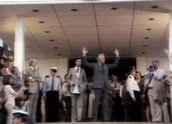


The Dismissal (1983)
Synopsis
On 11 November 1975, the Labor Prime Minister was dismissed by the Queen’s representative in Australia, the Governor-General, Sir John Kerr. The Dismissal brings to life the events leading up to this extraordinary event that shook the nation. The drama is played out in the Federal Parliament, the back rooms and the ministers’ offices, while the world of those now far off times is drawn through archival images and a fine narration to establish the point in history when the Arab oil embargo sent the world’s economies into a tail spin of inflation and unemployment for the first time since the Second World War.
Federal politics takes on a grimmer tone when Malcolm Fraser replaces the amiable but essentially light weight Billy Sneddon and the cut and thrust of the parliamentary system is ramped up for the larger than life, Prime Minister, Gough Whitlam. Whitlam becomes embattled by scandals caused by his ministers – Dr Jim Cairns and his affair with Juni Morosi, and Rex Connor’s dealings with a supposedly shady character from the Middle East, Khemlani of the petrol dollars. Both these ministers are consequently sacked, causing Labor to lose the balance of power in the parliament. This is the moment the leader of the opposition has been waiting for, and when Liberal controlled Senate refuses to pass the supply bill with the budget attached, the Commonwealth is threatened by the imminent prospect of running out of funds to run the country.
The climax of the film, the sacking of the Prime Minister, becomes inevitable when the character of the Governor-General is brought into the mix. Fraser plays him like a puppet and Whitlam seriously misunderstands the man to whom he gave the job.
Curator’s notes
Kennedy Miller produced one of the great Australian dramas based on actual events less than a decade after they took place. For five years the Broadcasting and Television Act had prohibited the dramatisation of the dismissal as then a current event. Eventually the series – which, at $2.6 million was the most expensive mini series made in the country at that time – was dramatised, with a cast of some of the very best Australian actors including Max Phipps as Gough Whitlam, John Stanton as the Liberal leader of the opposition, Malcolm Fraser and John Meillon as Sir John Kerr. Ruth Cracknell, John Hargreaves, Ed Devereaux, Bill Hunter, Robyn Nevin and Nancye Hayes were among the cream of Australia’s acting fraternity who lent their extraordinary talents to this important series. There were 115 speaking parts and one thousand extras and this was the first time that Kennedy Miller had worked in television.
The opportunity to move into television was presented to Kennedy Miller hard on the heels of it’s Mad Max success. The company was commissioned to develop programming for Network Ten, then owned by News Ltd, with News CEO Rupert Murdoch reportedly saying they could make anything, 'as long as it was bold’. The Dismissal was a ratings winner for the network. George Miller shared directing with Phil Noyce, George Ogilvie, John Power and Carl Schultz. Each director took two weeks to shoot a 50-minute episode.
Kennedy-Miller followed up this TV hit with several more successful mini-series for Ten – The Last Bastion (1984, directed by Miller), Cowra Breakout (1984). Bodyline (1984), Vietnam (1986), The Dirtwater Dynasty (1988) and Bangkok Hilton (1989).
- Overview
- Curator’s notes
- Video 3 clips

- Principal credits
- Find a copy
- Make a comment
- Map
- Add your review



